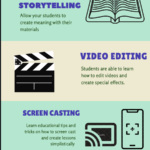Here is a brochure of my experience using Canva. I chose to embellish a poster of my teaching philosophy and add it to my teaching portfolio!

In this week’s blog post, I will be commenting on what makes an efficient instructional design model and elaborate on my personal favorite theory, inquiry-based learning.
According to this week’s reading and activities, there are several characteristics that build an effective instructional design model. I believe that inquiry-based learning encompasses all of the characteristics that are needed to facilitate successful learning. Inquiry-based learning goes beyond the traditional idea of a classroom, rather it begins to shape student’s minds to the unlimited possibilities of where learning can take them (Wolpert-Gawron, 2016). Inquiry-based learning is the idea of creating curiosity and inspiring students to develop questions. Students take ownership of their own learning and decide how and what they learn. In 2014, Jeff Hopkins quotes, “Education is not the filling of a pale, but rather the lighting of a flame”, and explains how learning should come within us, rather than outside us. Inquiry-based learning forms innate human curiosity, and positions learners to make sense of the world around them as well as encourages diverse thinking (Wolpert-Gawron, 2016). Driscoll & Carliner (2005) discuss how the instructional design is a bigger picture than the process, and the learner’s outcome represents a new and effective “framework of thinking”.
I encourage everyone, to take the time to watch this Ted Talk, featuring Jeff Hopkins. He explains how to take the next steps towards an Inquiry-based education, as well as how the students benefit at this level of instruction.
To embed inquiry-based learning in our education, the system needs to make a shift towards knowing, rather than knowing about (Hopkins, 2014). Thus, it is essential for teachers to incorporate inquiry-based learning to allow the learner’s the ability to construct knowledge and gain self-responsibility. Inquiry-based learning engineers this form of thinking and transforms the classroom towards the student’s ideas, thoughts, and questions (MacKenzie, 2021). Students have the opportunity to take charge of their own learning in the classroom and dictate their own knowledge construction.
This instructional design model facilitates learner-centered and goal-orientated characteristics as well as empirical and real-world implications (Richards, 2021). It also allows the students to work with each other as well as develop accountability for their learning (Richards, 2021). The only characteristic that is of concern is dictating a measurable outcome, as inquiry-based learning tends to be individualistic. However, according to Trevor MacKenzie and Jeff Hopkins, their students continue to demonstrate advanced academic achievement and become more passionate with regard to learning (MacKenzie, 2021). Therefore, inquiry-based learning has the ability to measure the outcomes of the students (grades, assignments, knowledge consumption), relating to their academic achievement.
This way of knowledge distribution prepares learners for higher education and life after university. We transition the students from the interpretation of material, towards learning that involves risk-taking, curiosity, and goal-setting (Wolpert-Gawron, 2016). Teachers would begin to prepare students for success and produce lifelong learners.
References:
MacKenzie, T. (n.d.). Inquiry Mindset Assessment Edition. Tmac. https://www.trevormackenzie.com/index
Wolpert-Gawron, H. (2016). What the Heck Is Inquiry-Based Learning? Edutopia. https://www.edutopia.org/blog/what-heck-inquiry-based-learning-heather-wolpert-gawron
Hopkins, J. (2014). Education as if People Mattered [Video]. TEDxVictoria. https://www.youtube.com/watch?v=5O5PK6LsymM
MacKenzie, T. (2021). Inquiry-Based Learning. Personal Communication EDCI 336.
Richards, L. (2021). Creating Multimedia Learning Objects and Aritfacts: Infographics & Augmented Reality. EDCI 337. https://edtechuvic.ca/edci337/2021/05/23/3-creating-multimedia-learning-objects-and-artifacts-infographics-augmented-reality/
Kurt, S (2015). “Instructional Design Models and Theories,” in Educational Technology. Retrieved from https://educationaltechnology.net/instructional-design-models-and-theories/
Cunningham, M (2021). Inquiry-Based Learning, EDCI 335.




lukejr
May 31, 2021 — 9:33 am
Great tie it to Jeff Hopkins’ work. As you say he is well worth the time to view/read his work.